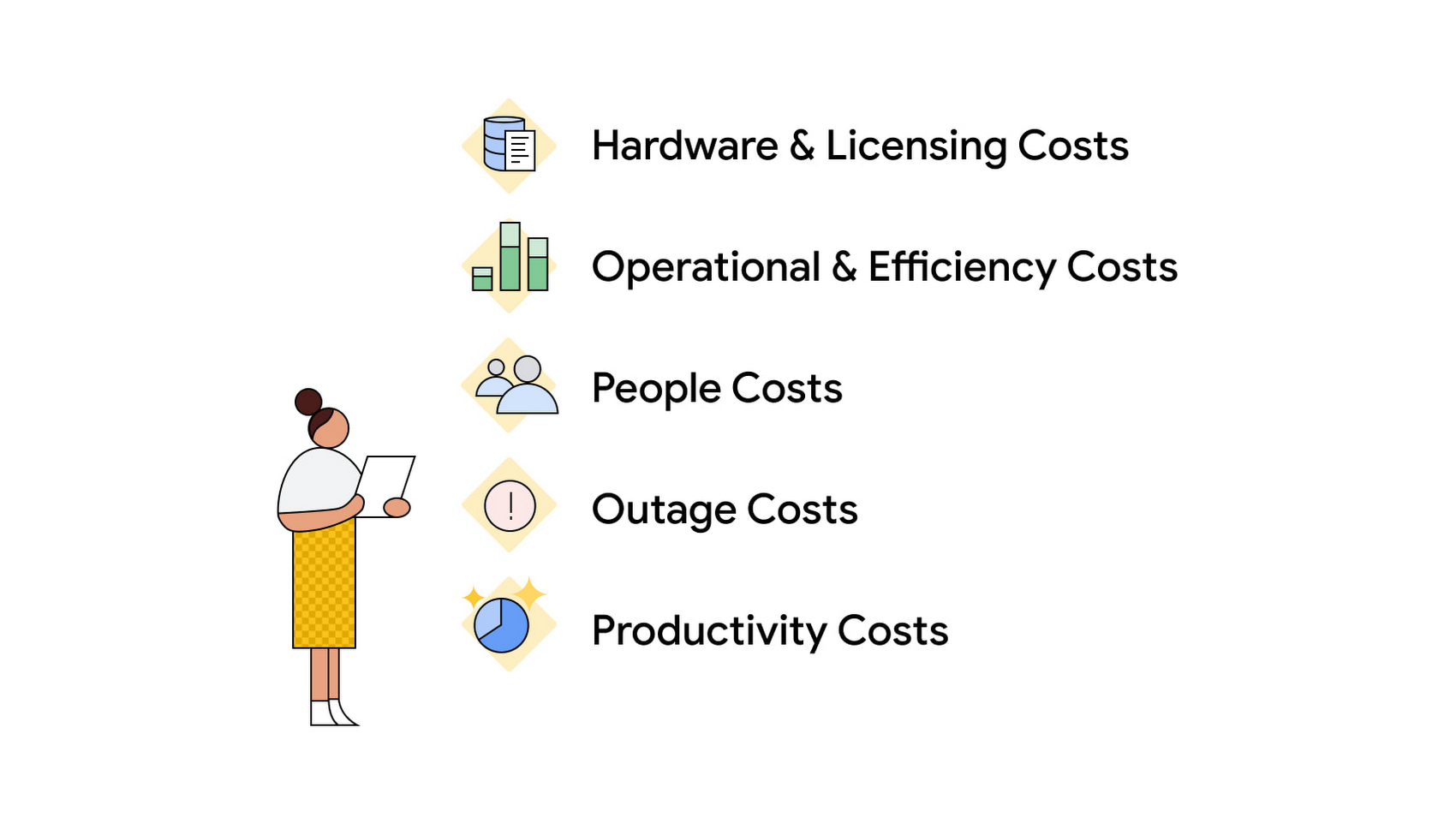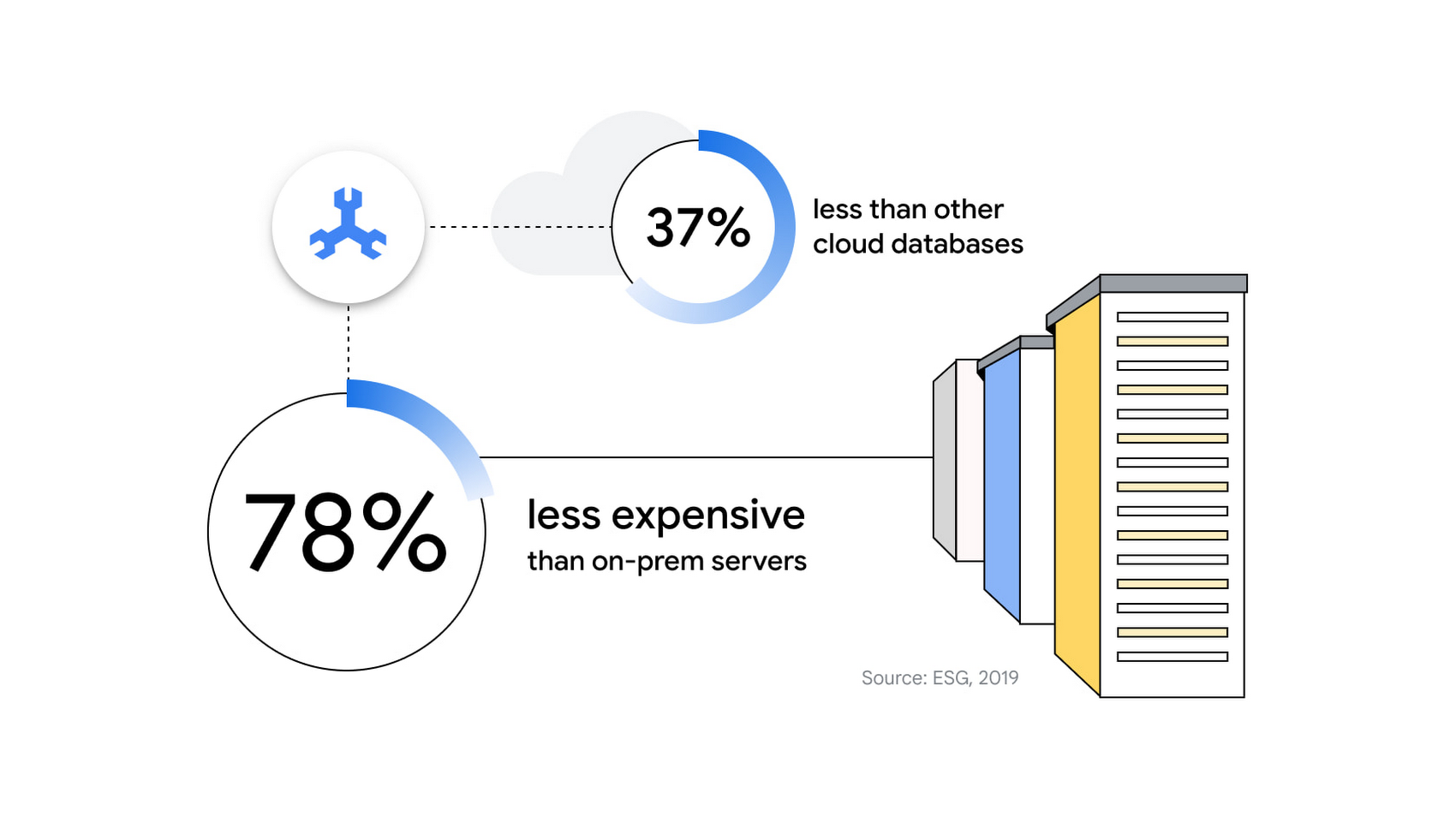Evaluating the true cost or TCO of a database — and how Cloud Spanner compares
Pritam Shah
Director of Engineering
Shambhu Hegde
Product Manager, Google Cloud
When you are looking to modernize your organization’s tech stack or build a new transformational application, your choice of database becomes important.
There are many factors including cost, security, scaling characteristics, self-managed vs. fully managed, on-prem vs. public cloud, etc., that go into the decision-making process.
Cost is one of the key considerations for businesses while selecting a database. So, how do you figure out the “true cost” of using a particular database?
In this blog, we go through a simple framework for evaluating the total cost of ownership (TCO) of a database technology, which will help you in the decision making process.
Five types of costs
At a high level, we can bucket all the costs associated with managing a database into 5 categories


Take the hypothetical example of an organization that wants to self-manage a database cluster. For the purposes of this exercise, we’ll define a database cluster as a setup that has more than one node (for e.g., a self-managed sharded MySQL cluster). Most scenarios also apply to self-managed databases in the public cloud.
1. Hardware and licensing costs
On-prem databases require upfront investments in hardware such as servers and storage disks, apart from indirect costs associated with planning, purchasing, and deployment of hardware.
Initial costs such as services needed to install, configure and tune the database software also add to the upfront costs.
A clustered/sharded database adds more complexity to this process, particularly when hardware and software components are from different vendors.
Self-managed databases in the public cloud also require provisioning of server machines and storage disks based on the peak workload demands. So, you will incur higher costs even when the databases have less load.
You will have to pay licensing fees for some database technologies (e.g. Microsoft SQL Server licensing fees).
2. Operational costs and efficiency
Operating and maintaining the database: Operating the database takes up a non-trivial amount of time and resources. You will need to plan and execute operating system and database version upgrades, testing before upgrades, continuous tuning and optimization, and security patches.
Depending on your database size and the database’s availability SLO, the cost can be quite high. For example, a company self-managing their scaled and sharded MySQL database may end up spending significant resources (in terms of both dollar and people costs) in operations and maintenance.
Scaling up and scaling out: If you are self managing a database, how do you plan for special events like Black Friday, New Year’s Eve, the Superbowl, or new product launches? If you overprovision the hardware, that’s an unnecessary cost during non-peak periods. Also, overprovisioning hardware means overprovisioned licenses. If you underprovision, you’re at a risk of missing business opportunities. If your product becomes an overnight success (e.g., a mobile game launch), you have to worry about your database not keeping up with demand. When your database hits a vertical scaling limit (e.g., machine size), you have to scale out using sharding, which means you incur additional costs including rearchitecting, making changes to your app, operational costs and possible downtime. Even if re-architecture is not required, non linear scaling remains a concern.
Data resiliency: To prevent data loss and ensure business continuity during server failures, network failures, or natural disasters such as heat waves or hurricanes, you need to plan for data resiliency by setting up data replication across data centers in physically separated locations/regions. There's a significant cost associated with this setup (hardware, software licensing costs, and potentially the licensing for the replication software), as well as an ongoing maintenance burden.
Geographic expansion: As your business grows to different geographical locations, you may need to replicate your database for reasons including data residency requirements and to reduce database interaction latency for clients/applications. Setting up replication, achieving data synchronization between replicas, avoiding split brain issues, and handling replica recovery from failures introduces significant operational costs.
Efficiency: Certain SaaS application providers (who are cloud customers as well) provision one database per customer. Managing a large number of customers translates into managing a large number of individual databases. This will cause inefficiencies, leading to higher operating costs.
3. People costs
As database maintenance tasks and database management complexity increase, you will need more experts to maintain your databases. Sometimes, these costs could be much higher than your overall infrastructure (hardware) costs.
4. Cost of outages
Direct revenue loss: This one is obvious — if your business is not up and running, it can cause a direct revenue loss. Even a partial database outage can cause revenue loss.
Operational toil: In case of a database-related outage, how much toil does it cause to your organization? How many resources does it take to be on call, respond, mitigate, conduct incident post-mortems and put in preventive strategies?
Contracts: Some business-critical workloads may have contractual and regulatory repercussions for outages or application downtime (e.g., stock exchanges, banks).
Brand trust issues: If your business is down due to database maintenance windows or database outages (low availability), you risk your brand being associated with lower reliability, and lower availability.
Opportunity costs: Are you spending your resources just managing databases and the associated infrastructure rather than leveraging them to enhance and build new capabilities to support the core business?
5. Productivity costs
Time to production: Do you have the right CI/CD pipeline to optimize your time to production? Do you need to set up multiple dev, pre-production and staging environments with different database instances as a path to production? What is the time and cost associated with maintaining multiple environments and a non-optimized (database-dependent) time to push a change to production? How much effort do you need to spend planning and preparing for applying schema changes?
Poor performance: Have you optimized your database for best application performance? A poorly tuned database can translate into poor application performance and wasted resources.
Slower application development: Does your database enable your organization to develop and launch applications quickly? Do you have a local copy of the database that you can download on developers’ machines (or laptops) for rapid development? Does the database have a familiar interface for faster development?
Increased Complexity: Do your developers have to spend significant effort working around the complexities of your database deployment? Do you need to allocate your rockstar developers to solving database scaling / reliability challenges instead of core business differentiators?
Calculating business benefits
When developing applications, ask yourself whether your database allows you to iterate quickly and push changes to the production environment quickly? The time it takes to deploy code to production will directly translate into how fast you can launch new applications or features and how fast you can innovate.
While we took the hypothetical example of a company running their own MySQL cluster, the list above applies to many other situations as well. When selecting a database, it is important to look at the total cost of ownership, or TCO. To solidify the points above, let's look at one of our managed database services, Cloud Spanner, and its TCO.
Introduction to Cloud Spanner
Cloud Spanner is a distributed, globally scalable, strongly consistent relational database service built specifically for the cloud. It not only offers SQL benefits with relational database structure, but also offers horizontal scalability typically offered by non-relational databases — so that users get the best of both. This combination is designed to deliver high-performance transactions and strong consistency across rows, data centers, regions, and continents with an up to 99.999% availability SLA and enterprise-grade security. Users can focus on building applications and delivering innovation, while Spanner fully manages database infrastructure, sharding, replication, and failovers, with no scheduled downtime.
Spanner TCO
An ESG study on the economic benefits of Cloud Spanner concluded that hosting your data onCloud Spanner is 78% less expensive than using on-premises servers and up to 37% less expensive than using other cloud databases.


Customers across different industries such as financial services, healthcare, retail, gaming, telecommunication, and technology are reducing their database TCO by migrating to Cloud Spanner. For example, ShareChat reduced the costs of its non-relational workload by 30% by moving over 120 tables with 17 indexes from AWS DynamoDB to Spanner. Learn how another customer, Kochava, realized significant savings by consolidating their relational workload running on hundreds of MySQL databases into fewer autoscaled Spanner instances.
Total database costs with Cloud Spanner
Let’s look at typical database costs when you run with Cloud Spanner.
Hardware and licensing
No need to over provision hardware or pay hefty licensing fees to use Spanner. You can simply pay-as-you-go for the database compute capacity and the storage consumed in Spanner. You can use Spanner autoscaler to flexibly scale up and scale down database compute capacity which drastically reduces the cost.
Operating and people costs
As a fully managed cloud database service by Google Cloud, Spanner lets you spend less time managing, and more time building applications and adding value to your customers. It is very easy to create backups and to restore; there’s no patching or upgrading required. You can roll out schema changes without downtime, and security is built-in.
Efficiency
Spanner allows you to consolidate several self managed databases into one instance and manage it efficiently.
Node costs
Spanner offers a Free Trial for 90 days. Spanner also has a downloadable Emulator, which can be used for correctness testing and development, completely free. Start for as low as $65 per month, and purchase Committed Use Discounts to further lower your cost by up to 40%.
Scaling
Start with 100 Processing Units (Smallest size) and go up to an unlimited number of nodes. Spanner can be scaled on demand without downtime as the application grows, so there is no need for over-provisioning to reserve capacity ahead of time.
Customers have reported that Cloud Spanner enabled them to enhance business agility, which allowed them to harness the value of their data to better service existing customers and open new revenue streams. Spanner gives you complete flexibility to have your database in a single region or multiple regions spanning the globe, with the ability to do stale reads or strongly consistent reads.
Security
Spanner offers, by default, encryption for data-in-transit via its client libraries, and for data at rest using Google-managed encryption keys. CMEK support for Spanner allows you to have complete control of the encryption key. You can also protect database backups with CMEK. Spanner provides VPC Service Controls support and has compliance certifications and necessary approvals so that it can be used for workloads requiring ISO 27001, 27017, 27018, PCI DSS, SOC1|2|3, HIPAA and FedRamp.
Availability
Spanner multi-region configuration offers 99.999% availability SLA with no maintenance windows or planned downtime. In case of a zonal or regional failure, recovery is automatic (no intervention needed) with 0-RPO (no data loss) and no loss in business continuity.
Replication
All data is automatically replicated to all the replicas in spanner and is included in the cost of a node.
Consistency
Spanner offers global external consistency guarantees. In traditional RDBMS environments, developers build application logic to handle transactions and/or eventual consistency. Because Spanner offers strong consistency, scale, and relational semantics including transactions, it can make it easier for developers to produce cleaner code.
Transform your applications with a lower TCO
In short, organizations rely on complex database management systems to ensure access to data and insights that they depend on to run their business operations. However, managing and maintaining these databases can be challenging from a total cost of ownership (TCO) perspective. Customers across industries such as financial services, retail, gaming, and healthcare are choosing Cloud Spanner databases to modernize and transform their applications at lower TCO. Get started with Cloud Spanner at no cost with Free Trial instances.


